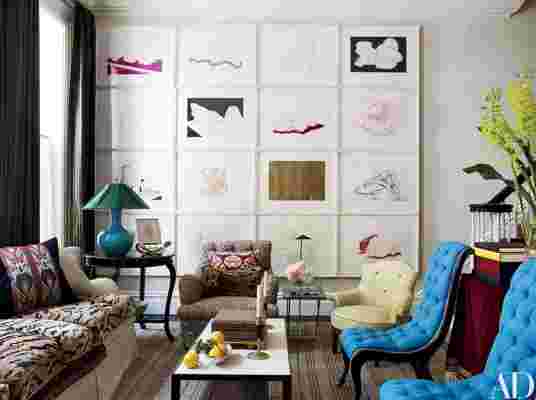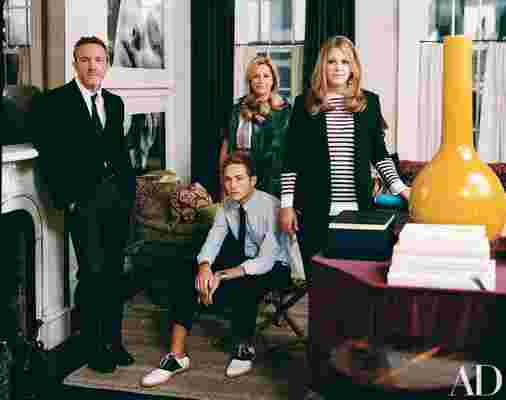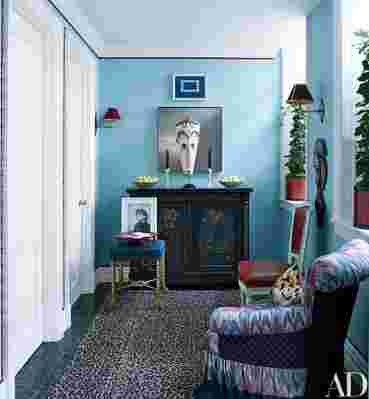May 02,2022
Jeffrey Bilhuber Revamps an 1870s Brownstone in Manhattan
by David Stewart
This article originally appeared in the February 2012 issue of Architectural Digest.
When Jenny and Trey Laird first set foot in the Manhattan townhouse that would become their family’s primary residence, they found it little changed from the 1870s, when the handsome four-story property was constructed a few blocks from Gracie Mansion by the Astor family, then preeminent real-estate developers. Marble fireplaces were intact, as were hefty moldings. However, the presence of hundreds of teddy bears—the previous owner was a granddaughter of Theodore Roosevelt—lent it a Miss Havisham aspect.
That was 16 years ago, before Trey founded the fashion advertising and branding firm of Laird + Partners , whose recent work includes campaigns for Bottega Veneta, Calvin Klein, Tommy Hilfiger, and Tory Burch. He holds fond memories of those early days, when son William, now 16, played handball against the house’s kitchen walls (the Lairds also have a college-age daughter, Allie). Guests at parties never noticed the scuffed paint, thanks to candlelight. Cosmetic upgrades were eventually made, but after a flood ravaged the first floor six years ago, the couple decided it was time to perfect their surroundings.
To be very clear, the Lairds do not make aesthetic decisions casually. “We’re the opposite of the client who says, ‘Here’s the check, we’ll be back in four months,’” Trey says. Jenny puts a finer point on it: “We could drive a designer insane.” Fortunately they turned to a man who understood their obsessive attention to detail— Jeffrey Bilhuber , who had decorated their weekend house in Bridgehampton, New York, years before.
The aim was to create the ideal setting for three decades’ worth of carefully accumulated furniture, objects, and art: textiles from Indonesia, porcelain from Japan, masks from South Africa. The legendary rooms of French decorator Madeleine Castaing—Proustian mélanges of whimsical Victoriana—loom large in their collective imagination, dating back to Jenny’s jaunts to Paris during college, when she and her mother would take tea with the venerable tastemaker. Bilhuber, for his part, brought logic to his clients’ belongings but is modest about his role. “Give credit where credit is due,” he says. “The Lairds just adore the creative process. Trey has made a career out of it.”
It was a highly sympathetic collaboration among three people besotted with history’s seminal interiors. “I can say, ‘Remember that Rothschild library with the amazing long sofa?’ and everyone gets it,” Trey says. “It’s a shared series of references.” As the decorating plans proceeded, the trio fell under the spell of papier-mâché chairs and spoke of rooms designed by Albert Hadley, Henri Samuel, and Billy Baldwin. Jenny wanted burlap-clad walls; Bilhuber told her she would hate the smell. (He was more receptive to her passion for tiger-stripe velvet.) At the same time, the 2009 Christie’s auction of the collections of Yves Saint Laurent and Pierre Bergé was holding Trey in its thrall. “Straight classicism has never been interesting to us,” he says. “It’s not personal enough. A house should reflect who you are and where you’ve been.”



To that end, Bilhuber came up with a brilliant solution. He devised a contemporary take on the townhouse’s past after studying late-19th-century photographs of interiors, inspired by their characteristic mix of the staid and the exotic. (In the living room, for instance, assorted fringes and tassels offer a nod, but never more than that, to the Astor era.) An informed eclecticism prevails, as evidenced by the tableau that appears when the dwelling’s glossy black front door swings open: an extravagantly shapely bench upholstered in a purple-and-currant-red suzani, placed beneath a neon-light sculpture by British artist Tracey Emin. At least that’s the tableau for now. As the interior designer explains, “I don’t expect the house ever to feel completed, because the Lairds’ curiosity will continue to be stirred.” Which is just fine with Bilhuber, who understands that the most appealing homes, instead of conveying a frozen splendor, are always ready to make way for another treasure.
A warm, often fanciful richness of texture courses throughout the house, in leopard-spot carpeting (a Castaing hallmark) laid over cool black Moroccan tiles and velvet armchairs posed against lacquered walls. In the tiny rear garden, the trelliswork is backed with mirror to visually enlarge the space. “That’s Jeffrey’s Halston moment,” Jenny says. The designer had a Hubert de Givenchy moment, too, when he surrounded the living room’s marble mantel in a panel of Japanese bronze mirror, in homage to an apartment the couturier once occupied at the Carlyle hotel in New York City. The panache reaches an exquisite high point in the dressing room on the third floor, where upper cabinets are accessed via a sliding ladder trimmed with brass nailheads. It took hours for designer and clients to agree on that precise metallic accent, a testament not only to the value of a magical detail but also to the pleasure derived in discovering it.
“This is not a minimalist place,” Trey says. “The philosophy was more is more.”






